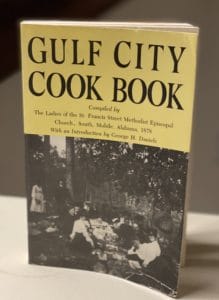MOBILE’S CONNECTION TO JAMBALAYA

Chris Andrews | March 20, 2020
What is your first thought when you hear the word “jambalaya”? Some may think of Mother’s restaurant in the French Quarter of New Orleans and their world famous jambalaya. You may have been to Gonzalez, Louisana, the “Jambalaya Capital of the World” to experience the yearly Jambalaya Festival. Others might refer to the Hank Williams song “Jambalaya on the Bayou.” Maybe your first thought is a box of Zatarains that you cook for dinner. Either way, your first thought is probably not the city of Mobile, Alabama. However, a look at the history of jambalaya suggests that hasn’t always been the case and that Mobile does indeed play an important role in the history of this famous dish.
In Spain, paella has been a signature dish of Spaniards for centuries. Paella is a dish of rice served with chicken or seafood, mixed with vegetables and cooked on a pan. When the Spanish began forming permanent settlements along the Gulf Coast in the 17th century they found that saffron rice, a main ingredient for paella, wasn’t very plentiful. The settlers found a suitable substitute with tomatoes to form their version of paella which some food historians credit as the first “jambalaya.”
The Spanish controlled the Gulf Coast areas of modern day Alabama, Mississippi and Louisiana from 1780 – 1812. They attempted to build an empire along the northern Gulf Coast. During that time, Mobile had a large population of Creoles. Creoles along the Gulf Coast have traditionally been a culture of people from French or Spanish and African descent. Creoles had their own unique culture of food, celebrations and heritage. Dishes like gumbo, jambalaya and turtle soup were unique Creole dishes found along the Gulf Coast. These recipes and dishes were passed down orally through the generations.
We find the first mention of the word jambalaya in print dating back to 1849. Solon Robinson was a writer and traveled the south during the 1830’s and 40’s. He would submit his writings to different magazines that would publish his works. In the May 1849 edition of the American Agriculturalists, Robinson writing from Mobile, Alabama published three Gulf Coast recipes. “Hopping John (Jambalaya)” was one of the recipes published. It consisted of “taking a dressed chicken or fowl cut into pieces, placed into a pot with a spoonful of butter and a chopped onion.”

The first and oldest known recipe in the United States for jambalaya arrives about 30 years later. In 1878, the women of the St. Francis Street Methodist Church, located off St. Francis Street in downtown Mobile, created a cook book called the Gulf City Cook Book. Inside on page 57 is a recipe for “Jam-Bolaya”. The recipe referred to using chicken, oysters and tomatoes mixed with rice.

The second oldest recipe in the United States for jambalaya came from a woman living in San Francisco, California by the name of Abby Fisher. In 1881, her cook book “What Mrs. Fisher knows About Old Southern Cooking” was published. Abby Clifton was born into slavery in South Carolina. Her father, a white farmer born in France, her mother a slave. Abby grew up and later married a man named Alexander Fisher, a minister and native Alabamian. The couple moved to Mobile sometime around 1860. Mrs. Fisher considered herself a “mullato” born of African and French descent. Abby Fisher, sharing the same descent as Creoles of Mobile certainly would have fit in socially throughout the 1860’s in the Creole culture of Mobile. A time well before the laws of Jim Crow and white supremacy dominated the political and social structures of the south.
Sometime in the 1870’s the Fisher family moved to San Francisco, California. While living on the West Coast, Mrs. Fisher was asked by many of her closest friends to share her cooking recipes for a cook book. Abby Fisher’s biggest obstacle in writing her book was that she couldn’t read or write. With the help of her friends, 160 recipes were published. One recipe she shared was “Jumberlie- A Creole Dish” using ingredients of chicken, ham and tomatoes. The Californians undoubtedly had a hard time translating the word jambalaya from her thick, Creole accent. “What Mrs. Fisher Knows About Old Southern Cooking” has gone down in history as one of the most celebrated cook books ever written by an African-American author.

Mobile certainly plays a large role in the history of jambalaya on the Gulf Coast.
We see the oldest mention of the word jambalaya and the first two uses of the word in a cook book both originating from The Port City.
While there’s no record of when the first jambalaya dish was consumed, Creoles in Mobile were certainly some of the first in America to serve this delicious dish. It would have been unspeakable in 19th century Mobile to not associate the city as a place to find some of the best jambalaya in the US.
Fast forward to today, very few restaurants have jambalaya on the menu. My challenge is to start recommending that chefs place jambalaya on their menus. Imagine if Mobile had restaurants with authentic, Creole jambalaya that honored our Creole foremothers. Combined with the rich history we have of this dish, this would surely solidify the city of Mobile as a place when you think of jambalaya.
